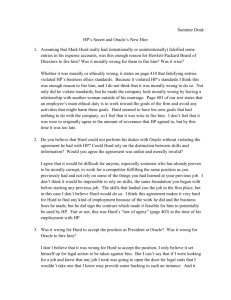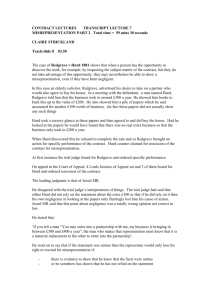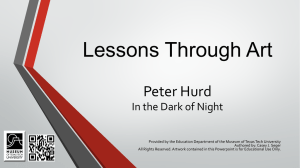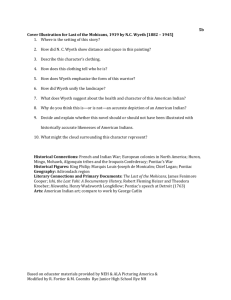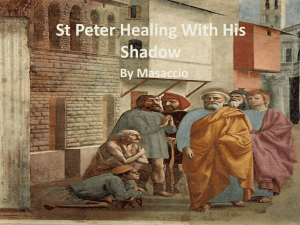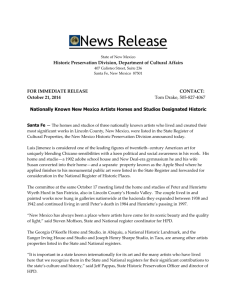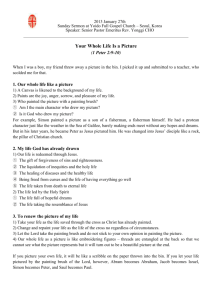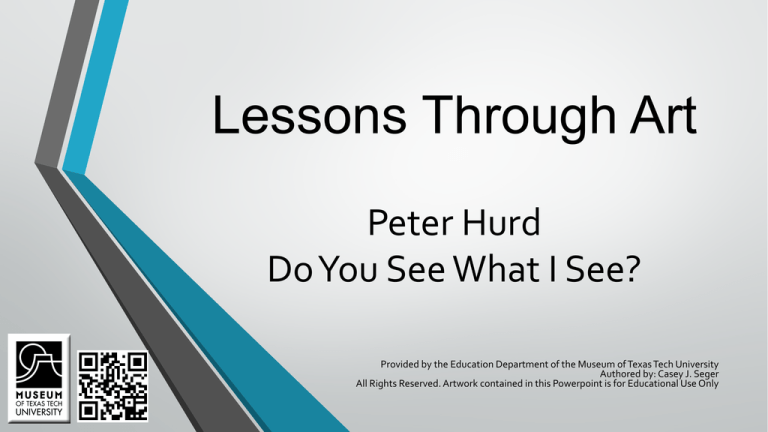
Lessons Through Art
Peter Hurd Do You See What I See? Provided by the Education Department of the Museum of Texas Tech University Authored by: Casey J. Seger All Rights Reserved. Artwork contained in this Powerpoint is for Educational Use Only Emphasis of Presentation • Study Focus: Peter Hurd • Title of Lesson Plan: Do You See What I See? • This Lesson Plan is mostly discussion based so add any extra evaluative materials deemed necessary for your purposes. • Grade Level: Grades 3-­‐5 Texas Essential Knowledge and Skills (TEKS) • Fine Arts • 117.11,14,17 •
•
• 113.14, 15, 16 History Geography Culture 126.7 •
Response and Evaluation • Social Studies •
•
•
• Technology Applications Technology Applications, Grades 3-­‐5 • English Language Arts and Reading •
110.14,15,16 •
•
•
•
Writing/Writing Process Research/Research Plan Research/Organizing and Presenting Ideas Listening and Speaking/
Teamwork Do You See What I See? Methods of Evaluation • Class Discussion • Student participation during research • Evaluation of Students’ writings Do You See What I See? Learning Objectives • Students will learn how location and time can impact an artist and their work. • Students will understand that artists often create their works of art from memory or sketches. • Students will learn that, within the United States, there are many different and distinct Native American Nations. • Students will participate in discussions using the painting Discovery of the Trail. Do You See What I See? Time Required • Two class periods of 45-­‐60 minutes each • One period for discussion of painting and research. • One period for presentation of research and class discussion. • Class size: 15-­‐20 students • Lesson plan can be adapted to meet class needs. • If you have more than the stated amount of students, forming groups would be beneficial. Do You See What I See? Materials Needed • Presentation of Peter Hurd (provided in this PowerPoint). • Image of Discovery of the Trail (provided in the PowerPoint). • Notebook • Pen or Pencil • Access to computer and research resources (library, etc.). Do You See What I See? Lesson Description Class Period One •
•
•
Begin with student presentation of Peter Hurd found in this PowerPoint. After the PowerPoint use the image of Discovery of the Trail as a starting point for lesson. Begin by asking students to write down their first impression of the painting: •
•
Where in the United States might you think Peter Hurd painted this scene? Do you think Peter Hurd visited this place before painting this scene? •
•
•
•
•
•
This question has no real right answer. However, based on knowing that Peter Hurd studied under N.C. Wyeth during his early years it is possible that he either used previous paintings done by N.C. Wyeth of his landscape or that he took short visits to the countryside to draw sketches to be used later. Discuss with the class these possibilities as well as other possibilities. Why would someone from the American Southwest paint scenes like this? What tribe do you think the Native American in this painting in from? While asking these questions feel free to develop your own as the discussion with the students progresses. Work into the discussion asking the students, “Who might Peter Hurd have been in contact with when he painted this image?” Remind them of Newell Convers (N.C.) Wyeth from the PowerPoint presentation. Ask if they have seen an N.C. Wyeth painting. Do You See What I See? Lesson Description (cont.) • After asking if they know of, or have seen, an N.C. Wyeth painting follow this link to the
Brandywine Museum to look at the illustration Last of the Mohicans by N.C. Wyeth.
• http://brandywine.doetech.net/Detlobjps.cfm?
ParentListID=81940&ObjectID=1237397&rec_num=2#42
• Click on icon image to increase the size.
• Show the illustration of N.C. Wyeth’s painting, Last of the Mohicans, along with the painting
Discovery of the Trail by Peter Hurd.
• Inform them that N.C. Wyeth painted this illustration for the cover of the 1919 edition of Last
of the Mohicans by James Fenimore Cooper while Hurd painted Discovery of the Trail in 1928.
• Finally, have students, as an assignment, write a one page summary of why Hurd might have
painted this scene almost 10 years after Wyeth, and almost 6 years after he started studying
under Wyeth. Also, ask them to compare these two paintings and write down similarities
and differences to discuss in the next class period.
Do You See What I See? Lesson Description (cont.) Second Class Period •
•
•
Begin the class period by asking each student to state the similarities and differences that they saw between the two illustrations. After discussing these similarities and differences start discussing the depiction of the gun in Hurd’s illustration and a bow and arrow in Wyeth’s. Begin discussing whether Native Americans would have had access to weapons used by European settlers, and how the Native Americans might have obtained these weapons (trade, warfare, etc.). •
Native Americans, especially those tribes in the Northeast and Coastlines, had access to firearms as early as the 1600’s. •
End with discussing which Native American tribes might be represented in Discovery of the Trail. Remind them that Hurd studied under Wyeth, who at the time was living in Chadds Ford, PA. Also, show the students on a map the area that Wyeth visited for his inspiration for the scenery of his illustrations, which was Lake George in upstate New York. •
Continue the discussion by making note that it is likely that Hurd painted Discovery of the Trail without actually meeting any person that belonged to one of the region’s tribes. Have the students discuss how this could impact the painting. Background Information • Peter Hurd was an artist from New Mexico who painted landscapes of the Southwest, along with other subjects. Hurd grew up in Roswell, NM. After three years in a military high school, Hurd enrolled in the United States Military Academy in West Point. However, after a few years he left West Point and began taking classes in art. Hurd studied under Newell Convers Wyeth and spent a lot of his time with the Wyeth family in Chadds Fork, PA. He eventually married N.C. Wyeth’s oldest daughter, Henriette. Hurd returned to New Mexico, settled in at his house in Sentinel Ranch, NM, painting local landscapes, portraits (including one of former President Lyndon B. Johnson) and scenes of ranch life. He died at the age of 80. Today many of his family members still use the Ranch as a place to paint. Peter Hurd Presentation for Students Peter Hurd 1904-­‐1984 Image Source: United States Bureau of Reclamation Peter Hurd • Born February 22, 1904 in Roswell, NM • Died in 1984 at age 80 • Started at West Point for Military Training and then left for art classes • Used the landscape around the family ranch in San Patricio, New Mexico, for inspiration. Peter Hurd • Early Years •
•
•
Studies the United States Calvary Drill Manual at the age of eleven. Learns from his father how to shoot guns. After three years in the New Mexico Military Institute, is accepted to West Point in 1921. • 1923 •
Leaves West Point to study at Haverford College with the intention of completing his formal education. •
•
Leaves Haverford College soon after entering the Pennsylvania Academy of Fine Arts. During this time becomes a friend to, and student of, N.C. Wyeth. • 1929 •
Marries Henriette Wyeth Peter Hurd • 1940’s • Serves as an illustrator for LIFE Magazine during WWII. (The resulting paintings and sketches can now be seen at the Pentagon in Washington, DC.) • Post WWII (after 1945) • Travels to Africa and Asia • Paints a portrait of Lyndon B. Johnson, meant to be the official portrait of President Johnson, but Johnson dismisses the painting, and the ensuing discussion about the painting increases Peter Hurd’s artistic reputation within the United States. Peter Hurd Discovery of the Trail, circa 1928 Oil on canvas (36 x 24 inches) Gift of the Diamond M. Foundation Collection of the Museum of Texas Tech University All rights reserved. Terms • Tempera-­‐A method of painting using pigments dissolved in an emulsion miscible with water, typically egg yolk. •
•
•
Resources and Bibliographic Materials Hurd-­‐La Rinconada Gallery and Guest Homes •
http://www.wyethartists.com/about-­‐peter/ •
If link does not work go to www.wyethartists.com and under the Artists tab locate Peter Hurd. Texas State Historical Association •
Robert Metzger, "HURD, PETER," Handbook of Texas Online (
http://www.tshaonline.org/handbook/online/articles/ou55), accessed July 18, 2013. Published by the Texas State Historical Association. •
If link does not work go to www.tshaonline.org and search “Hurd, Peter” and the page should be first on the search list. List of Native American Nations •
•
Last of the Mohicans-­‐ Picturing America •
http://www.teachervision.fen.com/native-­‐americans/printable/44308.html http://www.google.com/url?sa=t&rct=j&q=&esrc=s&source=web&cd=1&ved=0CCkQFjAA&url=http%3A%2F
%2Fpicturingamerica.neh.gov%2Fdownloads%2Fpdfs%2FResource_Guide_Chapters
%2FPictAmer_Resource_Book_Chapter_5B.pdf&ei=YX4rUqrQM4aTqQGb6ICwDw&usg=AFQjCNGdznroelbD28gap
J3yDhh-­‐g3Mo3A&bvm=bv.51773540,d.aWM

